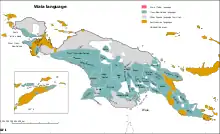Tabo language
Tabo, also known as Waia (Waya), is a Papuan language of Western Province, Papua New Guinea, just north of the Fly River delta. The language has also been known as Hiwi and Hibaradai.[3]
| Waia | |
|---|---|
| Tabo | |
| Region | Western Province, Papua New Guinea |
Native speakers | 3,000 (2002)[1] |
| Language codes | |
| ISO 639-3 | knv |
| Glottolog | tabo1241 |
| ELP | Tabo[2] |
 Map: The Waia language of New Guinea
The Waia language (south center)
Trans–New Guinea languages
Other Papuan languages
Austronesian languages
Uninhabited | |
Tabo means ‘word, mouth’ and is the name of the language, whereas Waia is the name of one of the ten villages where Tabo is spoken.[4]
Classification
Tabo is not close to other languages. Evans (2018) classifies it as a language isolate.[4] Usher (2020) includes it in the Trans-Fly family.[5] Part of the uncertainty is because many of the attested words of Tabo are loans from Gogodala or Kiwai, reducing the number of native Tabo words that can be used for comparison and thus making classification difficult.
Demographics
In Gogodala Rural LLG, Western Province, Papua New Guinea, Tabo is spoken in:[6][7]
- Lower Aramia River: Alagi (8.053774°S 142.961739°E), Galu, Saiwase (7.958242°S 143.203232°E), and Waya (7.984933°S 143.182042°E) villages
- Bamu River: Alikinapi village
- Lower Fly River: Kenedibi (8.240667°S 143.380404°E), Urio (8.239063°S 143.394333°E), and Wagumi-Sarau villages
- Segero Creek: Segero village (8.232149°S 143.536743°E)
It is spoken by 3,500 people mainly in the southern part Bamu Rural LLG of Western Province.[4]
Phonology
The phonemic inventory of Tabo is given below.[4]
- Consonants
- b, d, ɡ, p, t, k, m, n, l, w, j, h, s
- Vowels
- i, e, æ, a, o, u
Vocabulary
The following basic vocabulary words are from Reesink (1976) and Wurm (1973), as cited in the Trans-New Guinea database:[8]
gloss Tabo head wato hair hinibó; hinibɔ ear galo eye ba ͥdi; baidi nose dopo; dɔ:pɔ tooth lalo; lolo tongue mɛlpila; merapira leg nato louse tamani dog gaha bird hola; hola: egg kikipo blood hawi; haᵘwi bone goha; goha: skin tama breast nono tree ke'ha; kɛha man dubu; tubu woman kamena sun kadepa; kadɛpa moon manome; manomi water bea fire koe; kue: stone -nadi; naki road, path gabo name mahiro; mahiřo eat hɛna; nɛ:na one kapia two nete'ewa
Further reading
Schlatter, Tim. 2003. Tabo language grammar sketch (Aramia River Dialect). Unpublished m.s.
References
- Waia at Ethnologue (18th ed., 2015)
- Endangered Languages Project data for Tabo.
- Hammarström, Harald; Forkel, Robert; Haspelmath, Martin, eds. (2017). "Tabo language". Glottolog 3.0. Jena, Germany: Max Planck Institute for the Science of Human History.
- Evans, Nicholas (2018). "The languages of Southern New Guinea". In Palmer, Bill (ed.). The Languages and Linguistics of the New Guinea Area: A Comprehensive Guide. The World of Linguistics. 4. Berlin: De Gruyter Mouton. pp. 641–774. ISBN 978-3-11-028642-7.
- Eberhard, David M.; Simons, Gary F.; Fennig, Charles D., eds. (2019). "Papua New Guinea languages". Ethnologue: Languages of the World (22nd ed.). Dallas: SIL International.
- United Nations in Papua New Guinea (2018). "Papua New Guinea Village Coordinates Lookup". Humanitarian Data Exchange. 1.31.9.
- Greenhill, Simon (2016). "TransNewGuinea.org - database of the languages of New Guinea". Retrieved 2020-11-05.